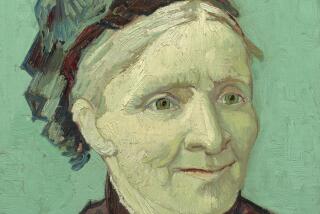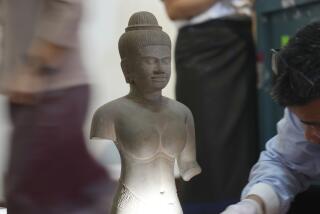Fit to be Thai
- Share via
San Francisco — In 1767, struggling American Colonists were just beginning to rebel against a new series of taxes imposed by the British. Half a world away, meanwhile, an epochal battle was transforming the social and cultural landscape of Southeast Asia.
Armies from Burma swept into Ayutthaya, the rich and powerful capital of a kingdom that foreigners called Siam. They destroyed the splendid city during a 15-month siege. More than a rout, the devastation was decisive. Almost overnight, Ayutthaya changed from a thriving, vibrant society into an esoteric legend.
At the Asian Art Museum in San Francisco’s Civic Center, an unprecedented exhibition has gathered together 89 examples from the great classical era of Thai art, which began with the official consecration of Ayutthaya (ah-YOOT-tah-yah) in 1351 and continued for more than four centuries. The works on view in “The Kingdom of Siam: The Art of Central Thailand, 1350-1800” include textiles, painted manuscripts and inlaid manuscript cabinets, architectural fragments, gold jewelry and -- mostly -- Buddhist votive sculptures. The quality is exceptionally high.
Fully expected are works such as an exquisite early 15th century copper head of a Buddha image. The rectangular, beautifully proportioned face, its knotted hair surmounted by a flame signifying enlightenment, projects unencumbered solemnity.
The eyes are heavy-lidded, averted from the shifting sights of the external world. The full lips -- relaxed into a gentle, almost imperceptible arc that is not quite a smile -- betray no inclination to speak. But the smooth, bilaterally symmetrical surface of the head, interrupted by the equally regular geometric patterning of the hair, encourages a holistic reading of the form rather than an analysis of individual parts. Despite its silence, this magnificent head is eloquent -- the sculptural embodiment of poise.
More surprising is a wild group of crowned and bejeweled Buddha images. They date from the 17th and 18th centuries, when Ayutthaya was at the apogee of its power. Extreme stylization makes these standing or seated figures seem like fantastic creatures miraculously arrived from other dimensions.
Elaborate decorative embellishments give them a regal aura. Bracelets encircle not just wrists but ankles, upper arms and even waists. Tiered crowns cap the Buddha’s cranium with the equivalent of a miniature temple tower.
Some are adorned with teardrop patterns in high relief, others with earrings and breastplates whose jagged edges recall swords and flames. These figures almost seem ablaze, as if enlightenment was a delirious fever and a kind of protective defense against the common brutalities of daily existence.
One crowned figure is shown seated cross-legged, in a familiar meditative pose, atop a large and stylized lotus blossom. A razor sharp line separates the row of flower petals across the sculpture’s base, cast in copper alloy, from a second row of inverted petals that creates a mirror image of the lotus. Without employing any illusion of water crafted in metal, a crisp reflection of the flower is implied. As if by magic the seated Buddha, eyes closed in inward meditation, seems to float.
Among the more unexpected masterpieces are the decorated manuscript chests. Furniture was apparently sparse in Ayutthayan temples and monasteries, but tall cabinets for storing religious texts were common. Here, form follows function -- if function is presumed to be more than merely mechanical, and to include the necessity for signaling grandeur and consequence.
The show’s breathtaking examples are of two types: lacquered and painted in gold, or inlaid with mother-of-pearl and glass. Like the illuminated manuscripts, the painted chests are partly important because they are just about all that remains of classical Thai paintings from the period, most of which were destroyed during the sack of Ayutthaya or from subsequent exposure to the elements or later restorations.
Whether painted or inlaid, however, the bristling imagery of plants, animals, mythical creatures or personages is dense, intricate and highly stylized. These are the products of playful imagination, which absorbs and supersedes natural observation. Such vivid decoration declares that the documents inside this chest are not to be taken lightly.
Some works in the show have been lent by important public collections in Philadelphia, Baltimore, London and Berlin. Others are from the Asian Art Museum’s own distinguished holdings. However, two-thirds of the exhibition comes from Thai national museums and palaces in Bangkok and Ayutthaya. Few have been seen in the United States before, and they aren’t likely to come this way again anytime soon.
Ayutthaya, up the Chao Phraya River from the modern Thai capital of Bangkok, had been a remarkable cosmopolitan center for more than 400 years. Located at the confluence of three rivers -- a geographic position that gave it unparalleled advantages for both agricultural and economic prominence -- the island-city was a hub for international trade. Traffic reached from Persia to Western Europe, as well as nearby India and China and neighboring Cambodia. Ayutthaya’s kings flourished longer than China’s celebrated Ming Dynasty ruled. Its streets and waterways were lined with hundreds of richly furnished temples, filled with Buddha images small and monumental.
Today, protected as a UNESCO World Heritage site, Ayutthaya is a languorous plain dotted with still-impressive ruins of Buddhist monasteries, monumental sculptural ensembles and imposing temples. Locals maintain ancient rituals and tourists roam. A visit several years ago demonstrated that even now, more than two centuries after its abrupt decline, a reverent sense of desire and obligation to remember what Ayutthaya was pervades the place.
Still, when Ayutthaya fell in 1767, it fell hard. What the Burmese didn’t burn or loot, the elements rapidly consumed. Restorations during the last two centuries have altered much of what was left.
One result is that most of the works in this show are fragments of an almost unknown world. And they represent a narrow slice of a complex society.
Almost everything here is connected to religious life. Maintaining temples and monasteries usually comes first, followed by the palaces whose power is so often connected to religious worship. The paraphernalia of the peasantry withers away and disappears.
The refined, courtly quality encountered at every turn is embodied in such magnificently sculpted objects as a 15th century gilded copper balustrade from a temple, in which a mythical serpent opens its mouth to let loose a phalanx of five smaller crowned serpents, baring fangs and staring bug-eyed. The excellent exhibition catalog, written by Asian Art Museum curator Forrest McGill and guest curator M.L. Pattaratorn Chirapravati, along with other scholars, explains its likely meaning: Old traditions associated serpents with the rainbow, and rainbows were the bridge between Earth and heaven.
What better image for the base of a major temple’s stairway? The ferocious serpent balustrade performs a guardian role -- the heads look something like the beast in “Alien” -- while its rainbow association promises the faithful that the journey to a higher truth is about to begin. The exquisite beauty of the sculpture sanctifies the experience while also asserting its power.
Spanning almost half a millennium with fewer than a hundred objects can only offer a faint sketch of an epoch -- imagine a similar survey of Italian art from Giotto to Canova -- especially one about which so little is known today. But the Asian Art Museum has synthesized past scholarship while opening new doors to further study. In effect these objects comprise a significant share of what is left of Ayutthaya -- and what is left is often astounding.
*
‘The Kingdom of Siam: The Art of Central Thailand, 1350-1800’
Where: Asian Art Museum, 200 Larkin St., San Francisco
When: 10 a.m. to 5 p.m. Tuesdays through Sundays, 10 a.m. to 9 p.m. Thursdays
Ends: May 8
Price: $10
Contact: (415) 581-3500, www.asianart.org
More to Read
Sign up for The Wild
We’ll help you find the best places to hike, bike and run, as well as the perfect silent spots for meditation and yoga.
You may occasionally receive promotional content from the Los Angeles Times.







